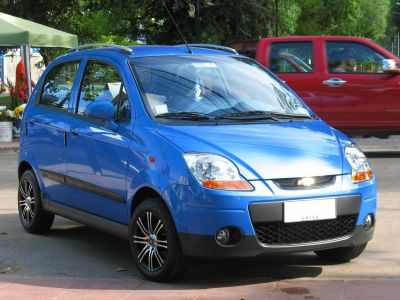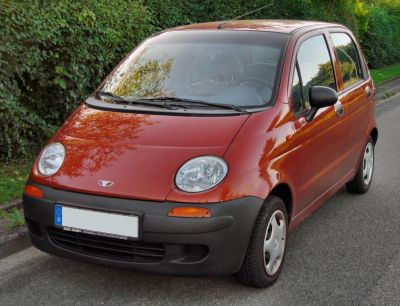 2000 Daewoo Matiz I (facelift 2000) Dimensions, Size & Specs
2000 Daewoo Matiz I (facelift 2000) Dimensions, Size & SpecsMeasurements of the 2000 Daewoo Matiz I, engineered for optimal performance and comfort
| Dimensions | |
|---|---|
| Length: | 3495 mm137.6 in11.5 ft |
| Width: | 1495 mm58.9 in4.9 ft |
| Height: | 1485 mm58.5 in4.9 ft |
| Trunk Capacity: | 145 liter5.1 cu ft |
| Trunk Capacity (Max): | 830 liter29.3 cu ft |
| Weight Specifications | |
| Curb Weight: | 806-826 kg1777-1821 lbs |
| Maximal permitted Weight: | 1210-1230 kg2668-2712 lbs |
| Tire Specifications | |
| Rims Sizes: | 13-inch rims:
|
| Tire Sizes: |
|
The Daewoo Matiz I facelift, produced from 2000 to 2005, is a compact hatchback designed primarily for urban environments where maneuverability and efficient use of space are key. Measuring 3495 mm (137.6 inches) in length, 1495 mm (58.9 inches) in width, and standing 1485 mm (58.5 inches) tall, this model remains a small but practical car choice. This small hatchback sits on relatively small 13-inch rims (4.5J x 13) fitted with tires sized 145/70 R13 or 155/65 R13, contributing to its nimble handling and easy parking capabilities. The vehicle's curb weight ranges between 806 and 826 kg (1,776 to 1,821 lbs), making it light and efficient, with a maximum allowed weight between 1210 and 1230 kg (2,668 to 2,712 lbs).
Despite its modest footprint, the Matiz I offers practical cargo solutions, providing a luggage capacity of 145 liters (5.1 cubic feet) with rear seats upright — sufficient for everyday needs such as groceries or small luggage. Folding the rear seats expands this space substantially to 830 liters (29.3 cubic feet), enabling greater flexibility for transporting larger items. This smart blend of compact exterior dimensions and optimized interior space made the Matiz a popular choice in dense cityscapes where parking space is limited.
The Daewoo Matiz I facelift demonstrates classic small car virtues: economical size, light weight, and functional design. Its compact dimensions, combined with a lightweight frame, help deliver fuel efficiency and ease of handling, perfect for inner-city commuting. In comparison to other vehicles in the sub-compact category, the Matiz I remains competitive by providing both compactness and surprisingly generous cargo capacity, making it an ideal hatchback for individuals or small families seeking a practical yet affordable vehicle during the early 2000s era.
Discover the standout features that make the 2000 Daewoo Matiz I a leader in its class
Have a question? Please check our knowledgebase first.
The Daewoo Matiz I facelift from 2000 has a compact exterior, ideal for urban driving. Its length measures 3495 mm (approximately 137.6 inches), making it easy to maneuver and park in tight city spaces. The width is 1495 mm (around 58.9 inches), which contributes to its narrow body profile, allowing it to fit through narrow streets comfortably. The height stands at 1485 mm (roughly 58.5 inches), providing reasonable headroom inside while maintaining a sleek hatchback silhouette. These dimensions classify the Matiz as a small city car, designed primarily for efficient urban use where space and agility are valued.
The curb weight of the Daewoo Matiz I facelift from 2000 ranges between 806 and 826 kg (approximately 1777 to 1821 lbs), while its maximum weight varies from 1210 to 1230 kg (about 2667 to 2712 lbs). This lightweight construction is key to the vehicle's nimble handling and efficient fuel consumption. A lighter car requires less energy to accelerate and maintain speed, which often results in better fuel economy, especially in city driving conditions where frequent stops and starts are common. Additionally, the lower weight aids in quick maneuverability, making the car agile in urban traffic. However, the relatively light weight may also translate to a firmer ride and less insulation from road vibrations compared to heavier vehicles.
The Daewoo Matiz I facelift from the year 2000 offers a luggage capacity of 145 liters (about 5.1 cubic feet) with the rear seats in their upright position. This is typical for small hatchbacks designed primarily for city use, sufficient for daily grocery shopping or small carry-ons. When the rear seats are folded down, the luggage capacity expands significantly to 830 liters (approximately 29.3 cubic feet), allowing for much larger items or greater cargo volume. This flexibility makes the Matiz practical for weekend trips or larger loads, despite its small overall size. It is important to consider the folding mechanism and seating arrangement when planning cargo space for optimal use.
Yes, the Daewoo Matiz I (facelift 2000) fits comfortably into a standard garage. Standard garages typically accommodate vehicles around 2.4 to 2.7 meters wide and 4.5 to 6 meters in length. With the Matiz’s compact size of 3495 mm (137.6 inches) in length and 1495 mm (58.9 inches) in width, it leaves ample room for ease of parking and opening doors within the garage space. This small footprint also makes the Matiz highly suitable for tight urban environments where parking spaces are limited and narrow. Drivers benefit from its agility and size when maneuvering in crowded city streets or parking lots. However, while the car fits standard garages easily, it’s always advised to measure specific garage dimensions if modifications or tight clearances exist.
The width of the Daewoo Matiz I (facelift 2000) at 1495 mm (58.9 inches) is narrower than many other hatchbacks, which often exceed 1600 mm (63 inches) in this dimension. This narrower width contributes to a smaller road presence, making the car look less bulky and more city-friendly. It enables easier navigation through congested or narrow roads and tighter parking spaces. Inside, the narrower width translates into a more compact cabin, which might limit shoulder room for passengers compared to larger vehicles. However, the Matiz efficiently utilizes its space with clever interior packaging to optimize comfort for small groups or city driving needs.
The Daewoo Matiz I facelift uses tires sized 145/70 R13 and 155/65 R13, mounted on 4.5J x 13 inch rims. These relatively small tires and rims are typical for compact city cars, designed to keep ride comfort and fuel efficiency high while maintaining affordability. Smaller wheels allow for lighter unsprung weight, which can improve handling responsiveness in urban stop-and-go traffic. However, smaller rims and tires generally mean less grip and a firmer ride on rough roads compared to larger wheels. The tire size chosen balances maneuverability and cost-effectiveness for the daily urban driver, prioritizing practicality over sporty performance.
The Daewoo Matiz I facelift introduced in 2000 did not significantly alter the core dimensions compared to the original Matiz launched in 1998. Both versions share a compact footprint with a length close to 3495 mm (137.6 inches), width near 1495 mm (58.9 inches), and a height about 1485 mm (58.5 inches). The facelift mainly involved minor cosmetic updates, interior tweaks, and mechanical refinements, rather than dimensional changes. This consistency ensured that the Matiz maintained its hallmark characteristics of urban efficiency and maneuverability. Buyers familiar with the earlier generation would notice improved styling and features without sacrificing the compact size they appreciated.
Compared to contemporaries like the Suzuki Alto, Fiat Seicento, or Hyundai Atos from the early 2000s, the Daewoo Matiz I facelift was quite competitive in size and urban functionality. Its length of 3495 mm (137.6 inches) positioned it very close to these rivals, usually ranging from about 3400 to 3600 mm. The 1495 mm width made it slightly narrower than some competitors, favoring tight city spaces but offering slightly less interior width. Its height of 1485 mm (58.5 inches) was typical for hatchbacks in this segment, providing adequate headroom. Luggage capacity with seats folded (830 liters) was competitive, offering flexibility. Overall, the Matiz balanced affordability, compact dimensions, and practicality well among small city cars.
Despite its compact exterior dimensions, the Daewoo Matiz I facelift from 2000 offers a surprisingly efficient use of interior space. The cabin design prioritizes maximum passenger room within a small footprint, providing reasonable headroom due to its height of 1485 mm (58.5 inches). Legroom and shoulder space are adequate for front passengers, though rear seating can feel tight for adults, particularly in width, given the narrow 1495 mm (58.9 inches) body. The upright seating position and large windows contribute to an airy cabin atmosphere and good outward visibility. While the Matiz is best suited for city commuting with small groups, its interior ergonomics and layout make it comfortable for short to moderate trips.
The Daewoo Matiz I facelift is primarily designed as a compact city hatchback with seating for four occupants — two in the front and two in the rear. While the rear bench technically accommodates three passengers, fitting three adults in the back is quite cramped due to the narrow interior width of 1495 mm (58.9 inches). The car's compact footprint limits rear legroom and shoulder space, making it uncomfortable for more than four people over longer journeys. Ideal usage involves two adults in front and one or two smaller passengers in the rear for short trips. For those frequently needing to transport more people comfortably, a larger vehicle would be advisable.
Discover similar sized cars.

| Production: | 2005-2009 |
|---|---|
| Model Year: | 2006 |
| Length: | 3495 mm137.6 in |
| Width: | 1495 mm58.9 in |
| Height: | 1485 mm58.5 in |

| Production: | 1998-2000 |
|---|---|
| Model Year: | 1998 |
| Length: | 3495 mm137.6 in |
| Width: | 1495 mm58.9 in |
| Height: | 1480 mm58.3 in |
